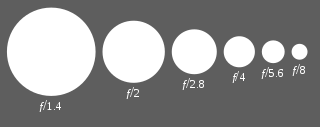1. There is no Google in the past.
2. When the answer is given to me (either in workshop, forum and etc.), I was like listening/reading Navi language.
3. When I asked the questions, I always (not 100%, some nice people really answer me, but it falls into number 2) get the answer "photography is an art, it is your skills count, not the technical knowledge".
4. As long as you can take nice photograph, and you know how to manipulate the mystery "f" number, who cares?
Despite the above reason, I still feel like being stab at the chest when someone actually ask me the questions "what is the f numbers mean?". This question always stunned me and feel shame as I don't really have no idea what it means. The only thing I know is it control the aperture, make it big or small. The smaller the f number, the bigger the aperture. and why is that? ARGGGGHHHH.........
Well, we all knows that wikipedia is a huge and nice encyclopedia, so I try to figure it out from there...and this is what I got in the first paragraph (taken from wikipedia):
F-number
From Wikipedia, the free encyclopedia
(Redirected from F-stop)
"F number" redirects here. For other uses, see F scale.
In optics, the f-number (sometimes called focal ratio, f-ratio, f-stop, or relative aperture[1]) of an optical system expresses the diameter of the entrance pupil in terms of the focal length of the lens; in simpler terms, the f-number is the focal length divided by the "effective" aperturediameter. It is a dimensionless number that is a quantitative measure of lens speed, an important concept in photography.
Damn, so pro, but I don't really understand it (since English is not my native language). This make me thinks, why can't someone write something in a lay man language? I know it is cool to sounds technical and pro, but the most important of knowledge sharing is to make someone to understand the idea behind it, right? That's why a hibiscus is called hibiscus and not by the name of Hibiscus rosa sinensis;
Ok, no luck with wiki, continue on Google......then I found this really cool site A Tedious Explanation of the f/stop. I was attracted to it due to its title. It sounds cool, so I went on and click on it. That's really lots of text on the page, but never mind, as usual I give a chance to the page by reading the first paragraph (I do have a believe that for any website you visit, if you can't understand the first paragraph you read, you'll have 0% chance to understand it). Ok, the first paragraph was easy to understand, so I went on to read the second paragraph...woohoo......read this:
"Despite being one of the exposure controls in photography, the f/stop remains a source of confusion and mystery to many photographers, even to some who use it all the time."
It speaks out my mind! So I went on and finish the reading.....finally, after so so so so many years, I understand what is the f-number, and why sometimes it is called f/2.8 instead of f2.8.
So, here is the summary:
- f/number is a formula.
- the "f" stands for the focal length of your lens.
- It is use to calculate the area of your aperture where light can pass through.
- The full formula is: area = n*r2 where n is π and r is the radius of the aperture.
- The aperture is calculated by: r = (f/ratio)/2 where f is the focal length of the lens and ratio is the number you saw either on the lens or on the camera screen. Example: You saw f2.8, the ratio is 2.8.
- f/ratio is representing the diameter of the aperture.
Oh ya, one more thing, don't try to use a ruler to proof the concept, because the area calculation is with assumption that the aperture blade is at the front elements of your lens while in real life, all the aperture blade is located at the rear of all the lens elements. So, it is a much more complicated life......:P





No comments:
Post a Comment